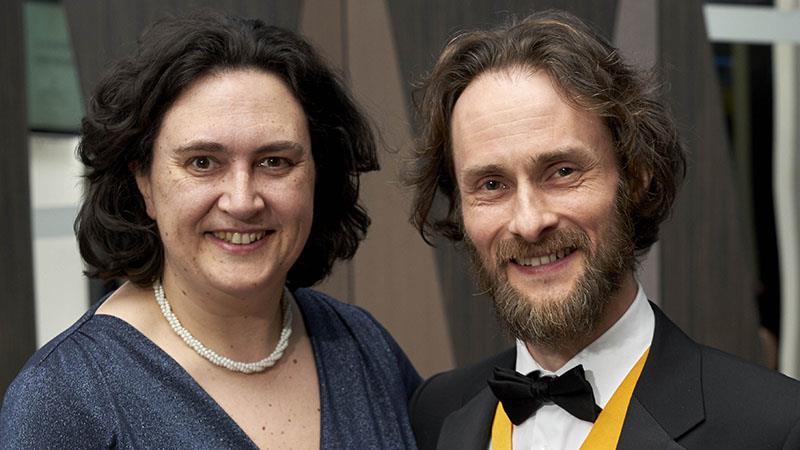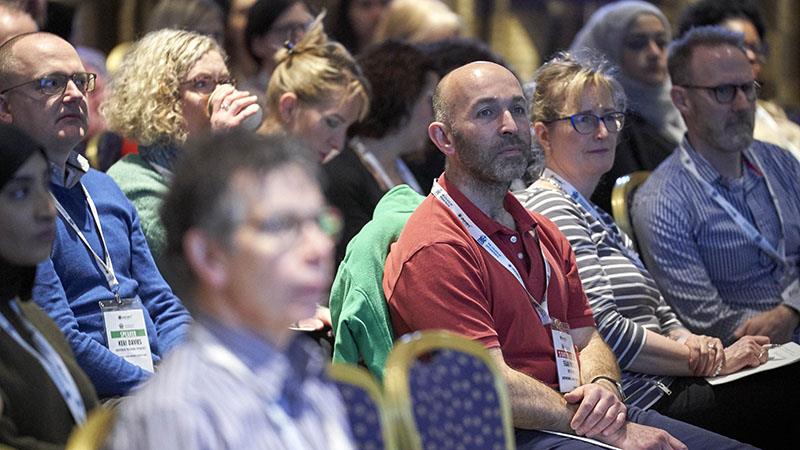Very different challenges facing eye care professionals across the globe were explored during this year’s Optometry Tomorrow conference in Birmingham.
The College of Optometrists annual event attracted 780 attendees over two days of lectures and workshops covering everything from dry eye to mobile phone screening apps.
Professor James Wolffsohn opened the second day presenting on how findings from last year’s DEWS II report can be applied in practice.
Practical workshops throughout the event delved further into the issue of dry eye as the warmer months approach and patient symptoms peak.
Meanwhile, Dr Andrew Bastawrous, CEO of smartphone-based vision screening enterprise Peek Vision, provided the Charter Lecture on improving access to eye care in remote and low resource settings.
Dr Bastawrous said: ‘The tragedy is of the 36 million people globally who are blind, four in five of them don’t need to be. They are blind from conditions we are already able to cure.
‘We have cost-effective treatments but the reasons why these treatments are not distributed is complex. For the majority it is because they are living in low-middle-income countries.’
Indeed, 90% of those with preventable blindness were living in these countries, primarily in sub-Saharan Africa and Asia.
Dr Bastawrous said: ‘This is in stark contrast to where eye care providers are – primarily in Europe and the Americas. Nowhere is that disparity more felt more than in sub-Saharan Africa.’
He noted that for every ophthalmologist working in Kenya, there were 100 working in the UK. Moorfields Eye Hospital itself, he said, has more ophthalmologists than the whole of Kenya.
‘As you go out to more rural parts of Kenya you can have a single eye doctor responsible for a population of three to five million people. And the biggest issue is uncorrected refractive error,’ Dr Bastawrous added.
He estimated that 2.5bn people globally would benefit from a pair of spectacles who did not wear them already.
‘These are problems we’ve been able to solve for a very long time and yet we’re not doing it,’ the ophthalmologist said.
From queues to crowd funding
Dr Bastawrous told delegates at Optometry Tomorrow the story of starting up a mobile eye testing enterprise in Kenya six years ago.

Dr Mary-Ann Sherratt and Professor Edward Mallen
Upon moving to Africa with his wife and baby son, they embarked on collecting data from local communities, using slit lamps and digital fundus cameras. Due to a lack of power supplies, everything was run from a petrol-powered generator.
‘Often these locations were quite stunning but incredibly difficult to get to,’ he said. ‘That is why so many people were being isolated from basic services.’
When they did manage to set up clinics, queues of 200-300 people formed – with the majority having uncorrected refractive error.
‘At first, I thought I would finally be doing the thing that would make me feel fulfilled and address this vast need. I soon realised even if we’d spend a day and a night seeing all these people it was never going to be enough.’
However, despite lack of access to electricity and water in many of the communities he reached, mobile phone technology was embraced and signals often strong.
Indeed, at the time 80% of people across the region had access to a mobile device. This was the catalyst for the creation of Peek, and the development of a mobile application to test vision.
‘We tried to make this as objective as possible to be done in the hands of anybody,’ Dr Bastawrous added. ‘It also means you no longer have to be an eye care professional to deliver a high-quality test. But we needed to know if it would work in the hands of non-eye care workers so we put it in the hands of community nurses, general volunteers and were able to get really good results.’

The technology has since evolved, eventually leading to the Peek Retina smartphone ophthalmoscope – as what was originally a research project evolved into a new product attracting funders.
‘I was reluctant to take investment, because for us we weren’t doing this to make gadgets. It wasn’t about making an app or a piece of hardware, it was about how do you use those things to reach people.’ Peek Vision now employs 20 members of staff at its London offices, while the Peek Retina device has reached 72 countries.
Dry eye matters
Despite the snowy backdrop to Optometry Tomorrow, this was fairly deemed as the right time of year to concentrate on dry eye, with air conditioning usually pumped up during the summer months.
In his presentation, Prof Wolffsohn told delegates how DEWS II had provided a new definition for dry eye and importantly differentiated it from ocular surface disease.
He said that dry eye was all too often seen as merely an annoyance whereas for patients it was ‘really impactful’. ‘This is something we need to take seriously and deal with,’ Prof Wolffsohn said, adding that dry eye was linked with productivity, depression and financial burden in the same way as other health issues such as angina.
The DEWS II committee looked into the full range of diagnostic tests for dry eye and was setting out to produce standardised patient guidelines, including diagnosing questions, risk factors, symptom assessment and tests for tear stability and osmolarity.
‘We as optometrists are not the only gatekeepers for dry eye,’ Prof Wolffsohn added. ‘It’s important when we are working in multidisciplinary teams that we have these guidelines.’
Practical tips to reduce dry eye included turning down the air conditioning, reducing salts, staying hydrated and avoiding drugs that cause dry eye, such as antihistamines.
Also at Optometry Tomorrow, optometrist Sarah Farrant ran a workshop on setting up a dry eye clinic, stressing that patients needed an ongoing treatment plan both within the practice and when they return home.
‘If you’ve got capacity in your practice already you need to think about how you are going to fit it in,’ Farrant said. ‘I don’t tend to do very intense follow ups because whatever the plan it takes three to four months for the improvements to kick in.’
On a practical level, delegates were advised they would need a slit lamp, fluorescein, Meibomian gland forceps, jewellers forceps and a golf club spud. ‘If you buy nothing else, buy a pair of Meibomian gland forceps,’ they were told.
‘You should also try to make your staff ambassadors for the clinic and ready for any questions patients may have. People are always likely to be non-compliant so the more you can educate them the more likely they are to be compliant,’ added Farrant.
Presidential handover
The College also welcomed a new president and five new Council members to Birmingham.
Incoming president Professor Edward Mallen said: ‘I am proud of our profession, and look forward to continuing the great work of our immediate past president, Dr Mary-Ann Sherratt. Optometrists are well-placed to improve the eye health of the nation. We are at a time of great opportunity right now, and I’m excited by the developments that could lie ahead.’
Meanwhile, Dr David Ehrlich won the Optometry Tomorrow Poster Prize 2018 for his poster entitled ‘Clinical tips for paediatric cycloplegic retinoscopy and fundi examination’.
Dates for next year’s event were confirmed as February 24 and 25, at the same venue. Meanwhile, Optometry Tomorrow Bitesize will be taking place on Sunday, October 7, 2018, at the Hilton Wembley.
